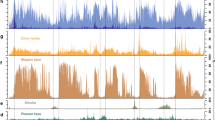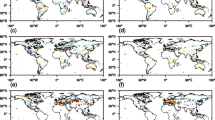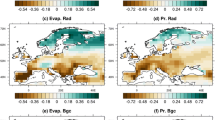Abstract
The atmospheric CO2 content is expected to continue to increase and probably induce warming at the global scale during the next century. The impact of such an increase will affect the composition and distribution of ecosystems on the same scale. To predict the integrated whole-ecosystem response to the CO2 increase in the Mediterranean region we used a vegetation biogeochemical model. This model (BIOME3) integrates monthly temperature and precipitation, some soil characteristics, cloudiness and CO2 concentration as inputs to simulate the vegetation in terms of biomes.
First we demonstrate the ability of the model to simulate past vegetation when tested versus pollen data. Second we use the vegetation model for different climate scenarios and report results of future changes in the Mediterranean vegetation.
These simulations indicate that an increase of the atmospheric CO2 to 500 ppmv, jointly with an increase of about 2 °C of the mean annual temperature, as simulated by several atmospheric general circulation models, should be accompanied by a severe reduction (more than 30%) of the present annual precipitation to change significantly the present vegetation surrounding the Mediterranean. When precipitation is maintained at its present-day level, an evergreen forest spreads in the eastern Mediterranean and a conifer forest in Turkey. In NW Africa, a woody xerophytic vegetation occupies a more extensive territory than today and replaces part of the present steppe area.
Similar content being viewed by others
References
Beerling, D.J., Woodward, F.I. and Jenkins, A.J. 1997. Testing the responses of a dynamic global vegetation model to environmental change: a comparison of observations and predictions. Glob. Ecol. Biogeogr. Lett. 6: 439–450.
Broccoli, A.J. and Manabe, S. 1987. The influence of continental ice, atmospheric CO2, and land albedo on the climate of the last glacial maximum. Climate Dynamics 1: 87–99.
Broccoli, A.J. 1994. Climate model sensitivity, paleoclimate and future climate change. In Long term climatic variations. NATO ASI series, vol. I22. pp. 551–567. Edited by J.C., Duplessy and M.-T. Spyridakis, Springer-Verlag, Berlin, Germany.
Ceulemans, R. and Mousseau, M. 1994. Effects of elevated atmospheric CO2 on woody plants. New Phytologist 127: 425–446.
Ceulemans, R. 1998. Responses of trees to climate and environmental change. In Proceedings of the European School of climatology and Natural Hazards course. pp. 159–181. Edited by D. Peter, G. Maracchi and A. Ghazi, European Commission, Directorate-General Science, Research and Development, Brussels, Belgium.
Cheddadi, R., Yu, G. Guiot, J., Harrison, S.P. and Prentice, I.C. 1997. The climate of Europe 6000 years ago. Climate Dynamics 13: 1–9.
Guiot, J., Cheddadi, R., Prentice, I.C. and Jolly, D. 1996. A method of biome and land surface mapping from pollen data: application to Europe 6000 years ago. Palaeoclimates 1: 311–324.
Haxeltine, A. and Prentice, I.C. 1996. BIOME3: An equilibrium terrestrial biosphere model based on ecophysiological constraints, resource availability, and competition among plant functional types. Glob. Biogeochem. Cycles 10: 693–709.
Hennessy, K.J., Gregory, J.M. and Mitchell, J.F.B. 1997. Changes in daily precipitation under enhanced greenhouse conditions. Climate Dynamics 13: 667–680.
Huntley, B. 1989. Migration: species' response to climatic variations caused by changes in the earth's orbit. J. Biogeogr. 16: 5–19.
Huntley, B. 1991. How plants respond to climate change: migration rates, individualism and the consequences for plant communities. Ann. Botany 7: 15–22.
IPCC, 1995. The climate change 1995. The science of climate change. Contribution of working group I to the second assessment report of the International panel on climate change. 572 pp. Edited by J.T. Houghton et al. Cambridge University Press, Cambridge, UK.
Jolly, D. and Haxeltine, A. 1997. Effect of low glacial atmospheric CO2 on tropical African montane vegetation. Science 276: 786–788.
Kallel, N., Paterne, M., Duplessy, J.C., Vergnaud-Grazzini, C., Pujol, C., Labeyrie, L., Arnold, M., Fontugne, M. and Pierre, C. 1997a. Enhanced rainfall in the Mediterranean region during the last sapropel event. Oceanologica Acta 20(5): 697–712.
Kallel, N., Paterne, M., Labeyrie, L., Duplessy, J.C. and Arnold, M. 1997b. Temperature and salinity records of the Tyrrhenian sea during the last 18,000 years. Palaeogeogr. Palaeoclimat. Palaeoecol. 135: 97–108.
Larcher, W. 1981. Low temperature effects on Mediterranean sclerophylls: an unconventional viewpoint. In Components of productivity of Mediterranean climate regions-Basic and applied aspects. pp. 259–266. Edited by N.S. Margaris and H.A. Mooney, Springer-Verlag, Berlin, Germany.
Leemans, R. and Cramer, W. 1991. The IIASA data base for mean monthly values of temperature, precipitation and cloudiness on a global terrestrial grid. RR-91-18. International Institute for Applied Systems Analysis, Laxenburg, Austria.
Le Houérou, H.N. 1979. North Africa. In Arid land ecosystems. pp. 83–107. Edited by D.W. Godall and R.A. Perry, Elsevier Amsterdam, The Netherlands.
Masson, V. Cheddadi, R., Braconnot, P. Joussaume, S., Texier D. & PMIP participants. 1999. Mid-Holocene climate in Europe: what can we infer from PMIP model-data comparisons? Climate Dynamics 15: 163–182.
Melillo, J.M., McGuire, A.D., Kicklighter, D.W., Moore III, B., Vorosmarty, C.J. and Schloss, A.L. 1993. Global climate change and terrestrial net primary production. Nature 63: 234–240.
Mitchell, J.F.B. and Warrilow, D.A. 1987. Summer dryness in northern mid-latitudes due to increased CO2. Nature 330: 238–240.
Pagani, M., Arthur, M.A., Freeman, K.H. 1999. Miocene evolution of atmospheric carbon dioxide. Paleoceanography 14: 273–292.
Peng, C., Wei, X., and Apps, M.J. 1997. Biogeographical models and their application to the global climate change studies: a review. Eco-environ. Res. Sustain. Develop. 0: 1–38.
Pennington, W. 1986. Lags in adjustment of vegetation to climate caused by the pace of soil development: evi.
Pons, A. and Reille, M. 1988. The Holocene and upper Pleistocene pollen record from Padul (Granada, Spain): A new study. Palaeogeogr. Palaeoclimat. Palaeoecol. 66: 243–263.
Prentice, I.C., Cramer, W., Harrison, S.P., Leemans, R., Monserud, R.A. and Solomon, A.M. 1992. A global biome model based on plant physiology and dominance, soil properties and climate. J. Biogeogr. 19: 117–134.
Prentice, I.C., Guiot, J., Huntley, B., Jolly, D. and Cheddadi, R. 1996. Reconstructing biomes from palaeoecological data: a general method and its application to European pollen data at 0 and 6Ka. Climate Dynamics 12: 185–194.
Raynaud, D., Jouzel, J., Barnola, J.M., Chappellaz, J., Delmas, R.J. and Lorius, C. 1993. The ice record of greenhouse gases. Science 259: 926–934.
Ritchie, J.C. 1986. Climate change and vegetation response. Vegetatio 67: 65–74.
Saugier, B. 1998. Environmental limitations of plant productivity. In Proceedings of the European School of climatology and Natural Hazards course: ‘Climate change impact on agriculture and forestry’. pp. 101–116. Edited by D. Peter, G. Maracchi and A. Ghazi, European Commission, Directorate-General Science, Research and Development, Brussels, Belgium.
Tarasov, P.E. Cheddadi, R., Guiot, J., Bottema, S., Peyron, O., Belmonte, J., Ruiz-Sanchez, V., Saadi, F. and Brewer, S. 1998. A method to determine warm and cool steppe biomes from pollen data; application to the Mediterranean and Kazakhstan regions. J. Quat. Sci. 13: 335–344.
van de Geijn, S.C., Schapendonk, H.C.M. and Rötter, R. 1998. In Proceedings of the European School of climatology and Natural Hazards course. Edited by D. Peter, Maracchi, G. and A. Ghazi, Springer-Verlag, Berlin, Germany. pp. 137–158.
Walter, H. and Straka, H. 1970. Arealkunde. Floristisch-Historische Geobotanik, Engen Ulmer Verlag, 478 pp.
Webb, T. III. 1986. Is vegetation in equilibrium with climate? How to interpret late-Quaternary pollen data. Vegetatio 67: 75–91.
Wilson, C.A. and Mitchell, J.F.B. 1987. Simulated climate and CO2-induced climate change over western Europe. Climatic change 10: 11–42.
Wijmstra, T.A. 1969. Palynology of the first 30 metres of a 120m deep section in northern Greece. Acta Bot. Neerl. 18: 511–527.
Woodward, F.I. 1987. Climate and plant distribution. Cambridge University Press, Cambridge, UK.
Author information
Authors and Affiliations
Rights and permissions
About this article
Cite this article
Cheddadi, R., Guiot, J. & Jolly, D. The Mediterranean vegetation: what if the atmospheric CO2 increased?. Landscape Ecology 16, 667–675 (2001). https://doi.org/10.1023/A:1013149831734
Issue Date:
DOI: https://doi.org/10.1023/A:1013149831734




